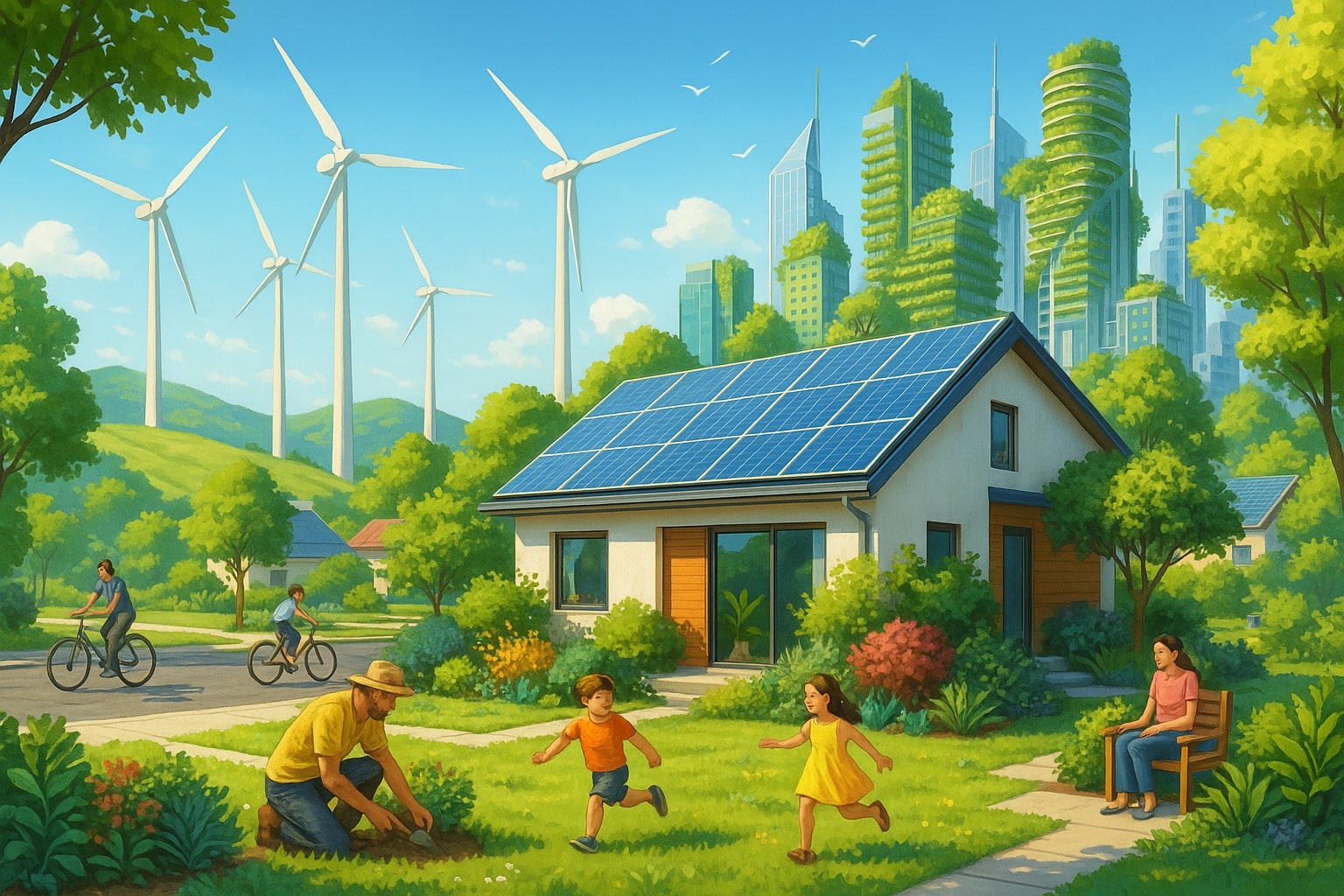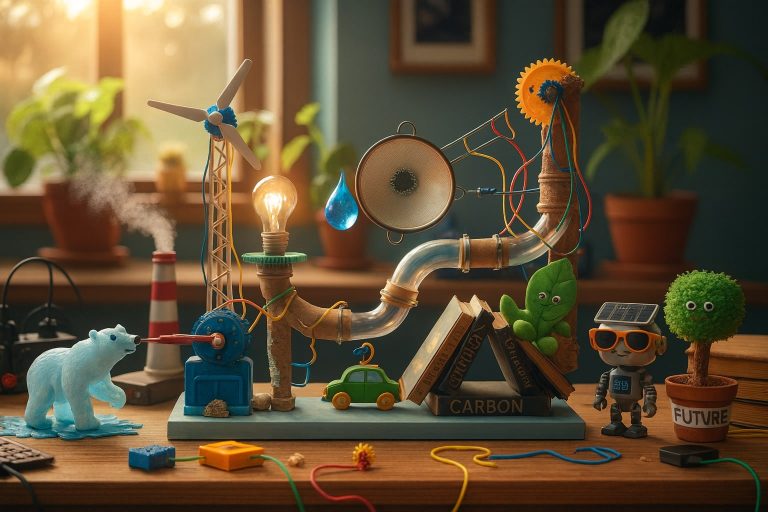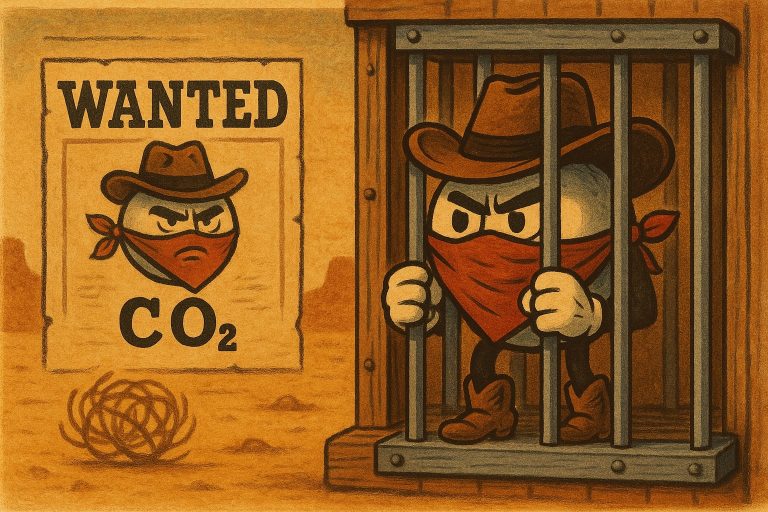“Meeting the needs of the present without compromising the ability of future generations to meet their own needs.”
That’s the official 1987 definition of sustainability from the UN’s Brundtland Commission.
Sounds fancy, right? But let’s unpack it with fewer syllables and more snacks.
Imagine walking into an all-you-can-eat buffet. Mountains of food. Rivers of soda. Dessert towers scraping the ceiling. You gorge like a champion. Feels amazing.
But—plot twist—the trays aren’t being refilled.
“Wait… that was the food for tomorrow too?”
Yep. That sinking feeling? That’s sustainability knocking.
You didn’t just eat lunch—you ate next week’s dinners, your kids’ breakfasts, and your grandkids’ birthday cake.
Humanity’s been on a buffet binge
For centuries, we’ve treated the planet like it’s an endless vending machine with no coin slot. We’ve razed forests, mined like there’s no finish line, and burned fuels like bedtime doesn’t exist.
Limitless consumption on a limited planet? That’s like trying to throw a pool party in a kiddie tub.
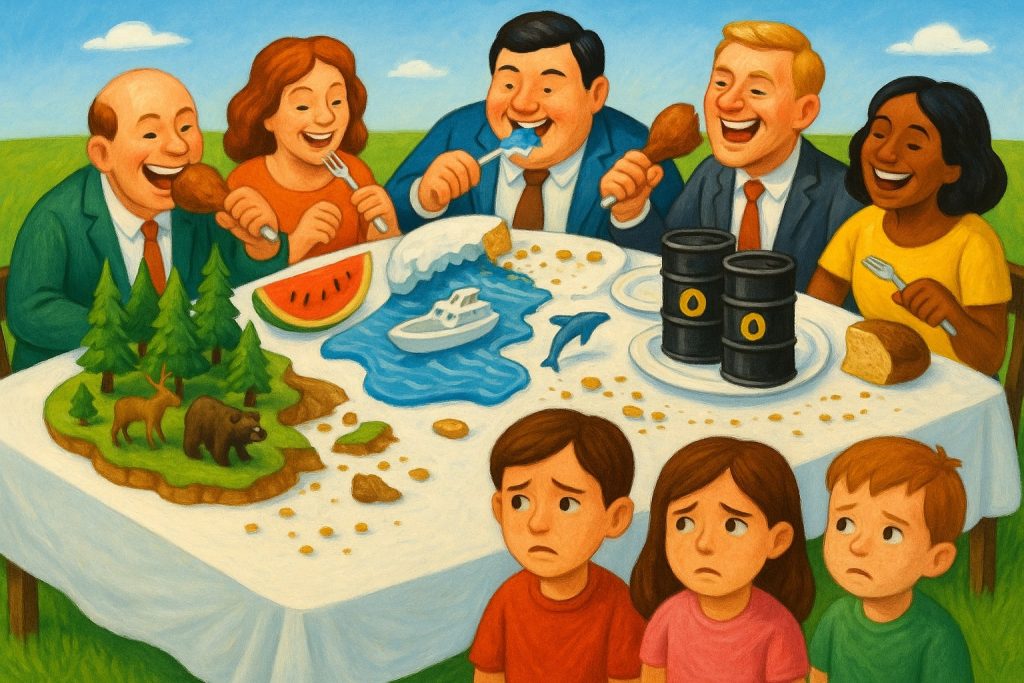
So, what now? Do we just stop living?
Nope. We evolve. We stop being nature’s freeloaders and start acting like we actually care.
Sustainability isn’t a punishment—it’s a smarter way to play the long game. It’s grown-up logic: don’t eat everything now and whine later.
It means reshaping how we build, move, eat, and chill—so there’s still a planet left for tomorrow’s guests.
Welcome to 1000whats—your backstage pass to the weird, the wow, and the wonderfully doable ways to help the planet. This isn’t a lecture in disguise or a guilt sandwich. It’s your chance to join the party where smart meets sustainable, spiced with humor and packed with real, useful ideas. Ready to dive in? Trust me, sustainability’s a lot more thrilling than it gets credit for. 🌍✨
What is sustainability?
Let’s get nerdy—but keep it fun.
The word “sustainability” traces back to Latin roots: sustinere, which means “to hold up.”
But no, this isn’t about ancient Romans lifting weights.
It’s about support, balance, and not letting things fall apart—like your favorite chair or, say, the planet.
Beyond the dictionary
Sure, the textbook says sustainability means “maintaining something at a certain rate or level.”
But once you toss it into the pot of environmental science, it simmers into something richer.
Think of it as a recipe where everything—air, water, soil, economies, communities—needs just the right ingredients to stay delicious.
Sustainability is nature’s way of saying: pace yourself, buddy.
It’s about keeping Earth’s systems humming so life—your dog, your grandma, that tree outside—can keep on thriving.
Not a new idea—just a forgotten one
The word may have hit the big leagues in the 1980s, thanks to a global report with the epic title “Our Common Future,” (Yes, that’s a mouthful. But hey, it sounds way cooler than “Please stop wrecking the planet.”)
That report, led by Gro Harlem Brundtland, dropped the now-famous definition:
Meeting the needs of the present without messing up the future.
Okay, they said it fancier—but you get the point. 😉
It’s not just about trees and turtles 🐢
Zoom out. Sustainability is an ecosystem of ideas.
In economics, it’s about using resources wisely—not blowing the budget on today’s party and forgetting rent is due next century.
Governments play a big role here, too.
They pass laws that reward clean energy, punish pollution, and invest in tech that doesn’t fry the atmosphere.
Tax breaks for solar panels? That’s sustainability. Limits on factory smoke? Also sustainability. Better public transport so you don’t need to drive three blocks? Yep—still sustainability.
More than money—it’s also about fairness
Now here’s the twist: true sustainability isn’t just eco-friendly. It’s people-friendly.
That means not just chasing growth, but chasing good growth. Growth that doesn’t leave whole communities behind.
If progress leaves half the people out, is it really progress?
Fair wages, equal access, clean air—these aren’t luxuries. They’re the foundation of a future that works for everyone.
What are the three pillars of sustainability?
Think of sustainability as a three-legged stool. If one leg wobbles, you fall flat on your face—gracefully, we hope, but still.
These three legs? Environmental integrity, social equity, and economic prosperity.
Let’s meet the trio keeping our planet balanced and our future hopeful.
🏞️ Environmental integrity
This one’s all about the Earth getting its due. Clean air, fresh water, fertile soil—it’s not just scenery, it’s survival.
Protecting ecosystems isn’t optional. It’s essential. Polluted rivers and disappearing bees might not sound like your problem—until your crops fail and breakfast vanishes.
Think about wetlands. They’re like Mother Nature’s Swiss Army knives:
🌾 Wildlife hotel
🌊 Flood sponge
🚰 Water filter
A healthy environment isn’t a luxury—it’s a life support system.
And here’s the kicker: when you protect nature, it pays you back.
Cleaner air means fewer hospital visits. Better soil means more food. It’s the best return on investment around.
🤝 Social equity
Imagine a party where only some people get snacks.
Unfair, right? That’s what happens when resources are unevenly distributed. Social equity means everyone gets a seat at the table.
Clean water, good schools, healthcare, and a voice in decisions? That’s not utopia. That’s basic dignity.
True sustainability means no one gets left behind—not even the quiet kid in the back.
It also makes everything else work better. Engaged communities protect their neighborhoods. Educated people make better decisions. And inclusive societies? They innovate like crazy. Clean energy in every zip code? That’s justice. Policies that include indigenous knowledge? That’s power sharing done right.
💼 Economic prosperity
Yes, money matters.
But not the “burn everything for a quick buck” kind of money. We’re talking smart, sustainable, future-friendly growth.
Sustainable economies create jobs that don’t destroy the planet. Solar panels don’t just power homes—they power paychecks. Green tech startups don’t just reduce emissions—they spark economic revolutions.
Prosperity isn’t about hoarding—it’s about building something that lasts.
A strong economy can fuel better education, healthcare, and innovation. And guess what? It circles back—educated, healthy citizens are better for the economy.
It’s like a feedback loop with a conscience.
How these pillars party together
Here’s the magic trick: these pillars don’t work alone.
They’re a team, not a solo act. Focus only on economic growth? You might trash the environment and widen inequality. Only on environment? You could cause job loss and social unrest. Only on equity? Great intentions, but without resources, progress stalls.
Sustainability isn’t a balancing act—it’s a symphony. 🎶
When all three pillars work in harmony, we get the good stuff:
🌿 Cleaner air
💰 Stronger economies
🤗 Happier, healthier people
Imagine a community-owned wind farm: It cuts emissions (environmental), creates jobs (economic), and lowers bills for everyone (social).
That’s a triple win—and a blueprint for the future.
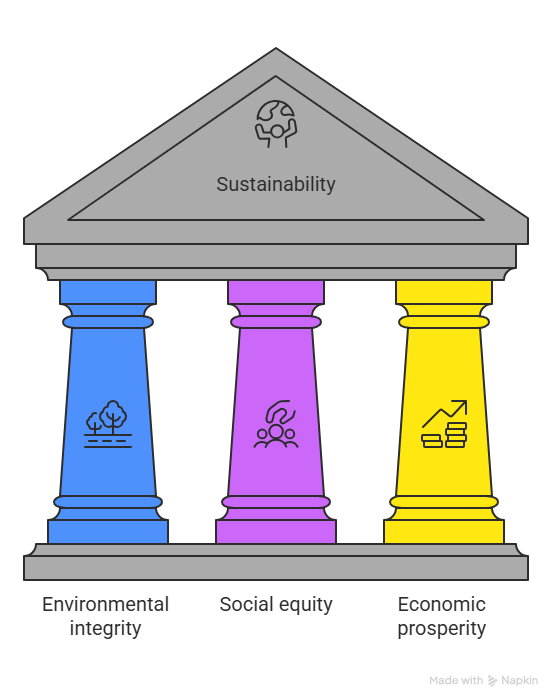
Why is sustainability important?
Everything we build, eat, wear, and click on—everything—comes from nature. Our entire civilization? Built on a long-term lease from Planet Earth.
The catch? We forgot to read the fine print.
Sustainability matters because Earth doesn’t do overdraft protection.
🔄 A History of using, then overusing
Once upon a time, humanity’s relationship with nature was like a friendly potluck. We took some berries, chopped a bit of wood, and the planet refilled the table.
Then came the Industrial Revolution—and we showed up to that potluck with a forklift and ate everything. Coal, oil, metals, trees—we yanked them out faster than nature could blink.
Sure, factories boomed and cities sparkled. But rivers ran black, skies turned grey, and forests? Gone. We got wealthier, yes. But also warmer, wetter, stormier, and sicker.
🧨 The cost of convenience
Today, we’re draining resources like there’s no sequel. Fish stocks are vanishing. Soils are tired. Groundwater’s running on fumes.
And our atmosphere? Think of it as a greenhouse with no thermostat. Burn enough fossil fuels, and you don’t just warm the air—you cook the planet.
Convenience today can mean catastrophe tomorrow.
The irony? Our economy still runs on the same resource-hungry model.
We depend on natural systems—energy, food, water—but we treat them like vending machines that never need restocking.
🧠 Enter sustainability: The smartest life insurance policy
Sustainability doesn’t say, “Stop using stuff.” It says, “Use it better. Use it wiser. Use it like you care.”
It’s not anti-growth—it’s pro-future. Think renewable energy instead of fossil freebies. Think regenerative farming instead of scorched earth.
It’s not about going backwards. It’s about moving forward without falling off a cliff.
🔧 Rebuild, rethink, reuse
This isn’t tree-hugging—it’s strategy. Long-term survival needs long-term thinking.
Sustainability builds resilient economies, fairer societies, and ecosystems that don’t buckle under pressure.
Imagine growing food without ruining the soil. Powering homes without choking the sky. Creating jobs that don’t require trashing rivers.
That’s not just possible—it’s necessary.
🎯 Why it all comes down to balance
We’ve seen what happens when we overreach—history is full of warnings. Today’s reality makes it clear: time is running out. What comes next? That hinges on the choices we make right now.
Sustainability gives us the tools to write a different story—one where we grow smarter, live lighter, and leave enough behind for those who come next.
And honestly? That’s a legacy worth fighting for.
What are the practical applications of sustainability?
Let’s cut through the buzzwords and dive into the good stuff: real-life, hands-on, rubber-meets-the-road sustainability.
Because here’s the deal—sustainability isn’t just for academic papers or eco-warrior documentaries.
It’s practical. It’s doable. And it’s happening all around us.
🏛️ Government and policy-level applications
Governments have power—and not just the “make-you-fill-out-forms” kind.
They shape how nations operate, and when they go green, big things happen.
- Regulations with teeth:
Think laws that cap emissions, boost energy efficiency, and reward green behavior. Europe’s going bold with its Green Deal, aiming to hit net-zero emissions by 2050. Ambitious? Yes. Necessary? Absolutely. - Sustainable cities in action:
Take Singapore. It didn’t just plant trees—it built a forest in the city. Their buildings breathe, their parks connect ecosystems, and their air smells like the future. - Follow the money:
Subsidies and tax credits turn eco-dreams into doable decisions. In the U.S., you can get paid (well, refunded) for slapping solar panels on your roof or switching to an electric car. 💸
Smart policy turns good intentions into real-world impact.
🏭 Corporate and industrial practices
Companies aren’t just jumping on the eco-bandwagon—they’re driving it.
- Greener brands:
From cutting carbon to swapping out materials, many businesses now bake sustainability into their strategies. Why? Because customers (and shareholders) care. - Smarter supply chains:
It’s not just what a company sells—it’s how they source, ship, and support it. Using recycled materials, paying fair wages, cutting waste? That’s sustainable business 101. - Resourcefulness pays off:
Lean manufacturing isn’t just efficient—it’s eco-savvy. Less waste, more profit, fewer dumpsters filled with regret.
Sustainability isn’t a cost—it’s an upgrade.
🏡 Community and individual actions
Sustainability starts at home—sometimes quite literally.
- Grow local, eat fresh:
Join a CSA (Community-Supported Agriculture) and your veggies come from a farm, not a freight truck. Bonus: You’ll know your farmer’s name. Possibly even their dog’s. - Green your castle:
Energy-efficient windows, low-VOC paints, bamboo floors—you name it. Your home can save energy and look stylish doing it. - Water-wise wins:
Low-flow showerheads. Rain barrels. Drought-tolerant landscaping. Your garden gets a drink, and the planet breathes a little easier. 💧
Sustainable living is just smart living—with fewer leaks and lower bills.
🌟 Examples of sustainability in action
- Costa Rica:
Over 98% of its electricity comes from renewables. It’s aiming to be carbon-neutral by 2025. That’s not just bold—it’s beautiful. - Freiburg, Germany:
This “green city” is basically a sci-fi eco-fantasy.
Bicycles rule the roads, solar panels crown the rooftops, and building codes are stricter than your grandma’s curfew. - The Zero Waste movement:
Some folks manage to fit a year’s trash into a mason jar. No joke.
Through reusing, composting, and rethinking everything they buy, they make garbage nearly obsolete. ♻️
Small steps, big impact
Sustainability isn’t just about global summits and billion-dollar projects. It’s in the lunch you pack, the lightbulbs you buy, the company you support.
Every choice adds up.
It’s not about being perfect—it’s about being persistent.
So whether you’re crafting national policy or just buying a better showerhead, you’re part of the shift.
And trust me, the future is thankful.
Why should we focus on sustainable energy?
If Earth had a status update, it might read: “Currently overheating. Please send solar panels.”
Switching to sustainable energy isn’t just a nice idea—it’s one of the smartest moves we can make for the future of our planet, our economies, and ourselves.
Think of renewable energy as a breath of fresh air—literally and figuratively.
💣 Fossil fuels: Dirty, finite, and a bit desperate
Let’s start with the usual suspects: coal, oil, and gas. Yes, they’ve powered everything from lightbulbs to global empires. But they’ve also filled the air with carbon dioxide and our timelines with climate disasters.
Burning fossil fuels is like heating your house by setting your sofa on fire. It works—but only for a hot minute. And then you’re out of sofa.
In 2019 alone, the electricity sector belched out over 23 billion metric tons of CO₂. That’s not a typo. That’s “goodbye polar ice caps” levels of pollution.
And the damage isn’t just in the air:
- Oil spills ruin oceans
- Mining tears up landscapes
- Drilling wrecks habitats
All of which adds up to one big message from nature: “You’re doing too much.”
🌞 Renewables to the rescue
Now enter the good guys—solar, wind, hydro, and friends.
- No smoke, no guilt: They generate energy without spewing pollutants.
- Endless supply: The sun doesn’t invoice us. The wind doesn’t charge rent.
- Low drama: No oil spills, no mining scars, no geological heartbreaks.
Renewable energy doesn’t just lower emissions—it raises the bar for what’s possible.
🧮 It’s also just… smarter economics
Fossil fuels are getting harder to find and pricier to extract. It’s like digging deeper into a piggy bank and finding only IOUs.
Meanwhile, renewable tech is getting cheaper, faster, and more efficient. Today, solar panels are more affordable than ever, and wind turbines practically print electricity on breezy days.
Plus, investing in renewables creates jobs—clean ones, in every sense of the word.
🌍 A future we can plug into
Sustainable energy is our ticket to a cleaner, safer, and more stable world. It’s not just about keeping the lights on—it’s about not burning down the house while we do it.
So the next time someone asks, “Why go renewable?” You can say: “Because burning dinosaur juice is a weird way to run a planet.”
How sustainable is renewable energy?
Let’s be honest—renewables have been getting a lot of hype. Solar panels, wind turbines, geothermal magic—it all sounds like the green dream.
But here’s the smart question: “Are renewables themselves sustainable?” And the answer? Mostly yes—but with a few asterisks.
Renewables are like superheroes—they’re powerful, inspiring, but not without their kryptonite.
🌬️ The bright side: Clean, green, and lean
First, the good news. Really good news.
Renewables generate electricity with barely a puff of pollution. No smoke stacks, no oil spills, no carbon hangovers.
- Wind energy? Slashes emissions by over 40% compared to old-school fossil fuels.
- Solar? Sips sunlight and powers homes without belching out greenhouse gases.
- Hydro and geothermal? Quiet workhorses with serious output.
They don’t need to be constantly fed fuel, and once they’re up and running, the ongoing environmental impact is minimal. They’re basically the strong, silent types of the energy world.
Renewables don’t just reduce pollution—they rewrite the rules of energy.
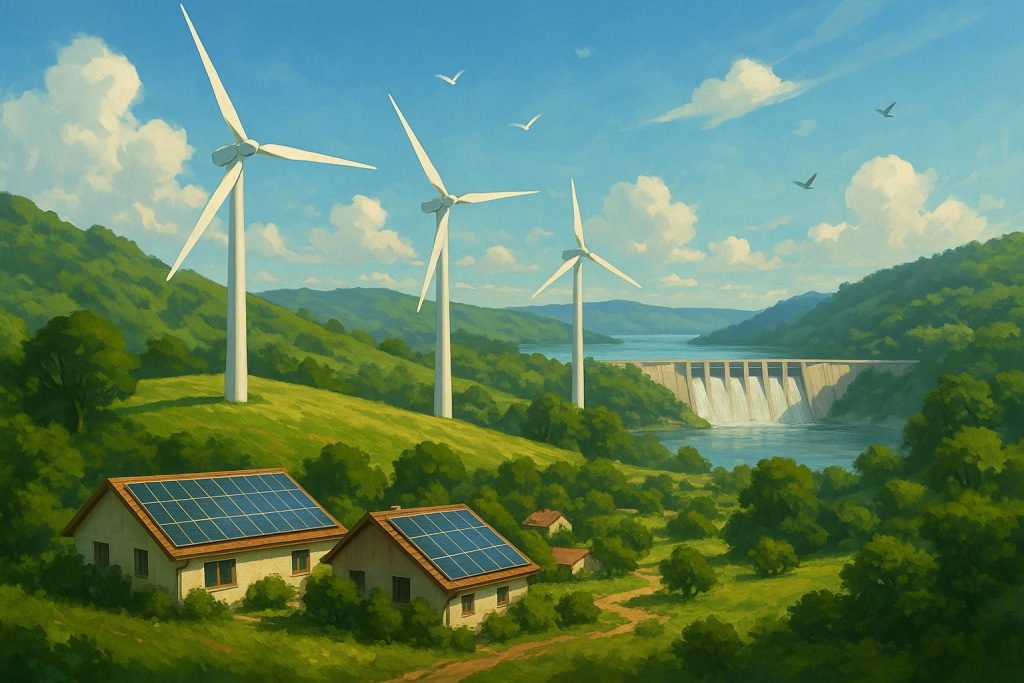
🧱 The Catch: Not perfect, but fixable
Now, let’s lift the solar panel and peek underneath.
Resource extraction and manufacturing: To build a turbine or panel, you need stuff—like lithium, copper, and rare earth metals. Mining these materials isn’t exactly a picnic for the environment. It uses fossil fuels, disturbs land, and can have social impacts too.
So yes, we’re trying to escape the fossil fuel trap… but we’re still holding hands with it during manufacturing.
Ecological impact: A giant wind farm may look majestic, but birds might not agree. Massive solar installations? They’ve bulldozed habitats in some desert ecosystems. Hydroelectric dams? Powerhouses, sure—but they’ve also drowned valleys and disrupted river life.
Nature needs a seat at the design table.
End-of-life management: Solar panels and turbine blades don’t last forever—20 to 30 years is typical. Then what? Currently, recycling tech for these materials lags behind the demand.
The result? A growing pile of green tech waste with nowhere to go.
Intermittency and storage: The sun doesn’t punch in on cloudy days. The wind? Totally unreliable as an employee. That’s where batteries come in. But building those batteries? You guessed it—more mining, more materials, more environmental baggage.
Even the cleanest energy leaves a footprint—we just have to shrink it smartly.
🔧 The way forward: Smarter, sharper, and more circular
We don’t toss the baby out with the solar-heated bathwater.
Instead, we innovate.
- Better recycling for solar panels and wind blades
- Less invasive mining methods
- Eco-conscious site planning to protect wildlife
- Grid upgrades and smarter storage to handle energy ups and downs
The transition to renewables isn’t about perfection—it’s about momentum.
Renewables aren’t flawless. But they’re fixable, scalable, and leagues better than burning the past to power the future.
So next time someone says, “But what about the waste from solar panels?” Smile and say, “Yes, we’ve got work to do—but at least we’re working toward a future we want to live in.”
How can I contribute to a sustainable life?
Let’s be real: saving the planet can sound like a pretty tall order when you’re just trying to get through Monday. But here’s the truth—sustainability doesn’t require a solar farm in your backyard or making your own shampoo from moss.
It’s about simple, doable shifts that add up.
You don’t need to change everything—just change something, and do it often.
🏠 Start at home: Your personal sustainability lab
Your living space is the perfect launch pad.
- Light smarter: Swap out those old bulbs for LEDs. They last longer and use way less energy.
- Plug unplugged: Devices suck power even when they nap. Unplug them or use a smart power strip.
- Chill wisely: A smart thermostat can be your quiet little energy ninja. So can properly sealed windows.
And water? Easy wins there, too.
- Fix leaky taps (seriously, one drip can waste gallons).
- Install low-flow showerheads.
- Keep showers short. Hum quietly. Done.
Feeling ambitious? Catch rainwater for your garden. Nature’s giving out freebies—why not collect?
🚲 Travel with intention (and maybe less exhaust)
Your commute matters more than you think. Cars cough out carbon every time we drive solo to the corner store.
- Walk or bike if you can—your lungs will thank you.
- Bus, train, carpool? Fewer cars, less smog. It’s math and it works.
- Got a car? Keep it efficient. And when it’s time to upgrade, check out hybrids or EVs. They’re cooler than you think.
Travel light. Not just your luggage—your footprint too.
🛒 Shop like the Earth’s watching
Turns out, where and how you shop speaks volumes.
- Buy local. Fresher food, lower transport emissions, stronger community.
- Dodge single-use plastics like they’re expired milk.
- Tote your own bags. Easy. Reusable. Stylish, even.
When it comes to clothes: buy less, choose better.
- Skip the fast fashion frenzy.
- Thrift stores? Full of gems.
- Clothing swaps? Free and surprisingly fun.
♻️ Reduce. Reuse. Reboot your habits.
The three R’s are classics for a reason.
- Reduce: Ask “Do I really need this?” If not, skip it.
- Reuse: Get creative. Old jars become plant pots. T-shirts become rags.
- Recycle: Do it right. No greasy pizza boxes in the blue bin, please.
And compost! It’s the unsung hero of your kitchen scraps.
Your garden (and the Earth) will eat it up—literally.
☀️ Back clean energy (Even if you don’t own a windmill)
You don’t need a Tesla roof to support renewables.
- Choose a green energy provider if your area offers it.
- Join a community solar project.
- Got the means? Solar panels are a long-term high five to the planet.
Every kilowatt-hour from the sun is one less from a smokestack.
🗳️ Learn. Speak. Vote. Repeat.
Knowledge is power. But sharing it? That’s real energy.
- Stay curious. Read, watch, ask questions.
- Chat about what you learn. (Yes, even at awkward family dinners.)
- Vote for leaders who give a hoot about the planet.
- Support local green projects and policies.
Celebrate the small stuff 🎉
This isn’t about being perfect—it’s about showing up.
Take pride in every light switched off, every plastic bottle skipped, every neighbor inspired.
That ripple effect? It’s real.
Progress, not perfection. That’s how we save the world—one choice at a time.
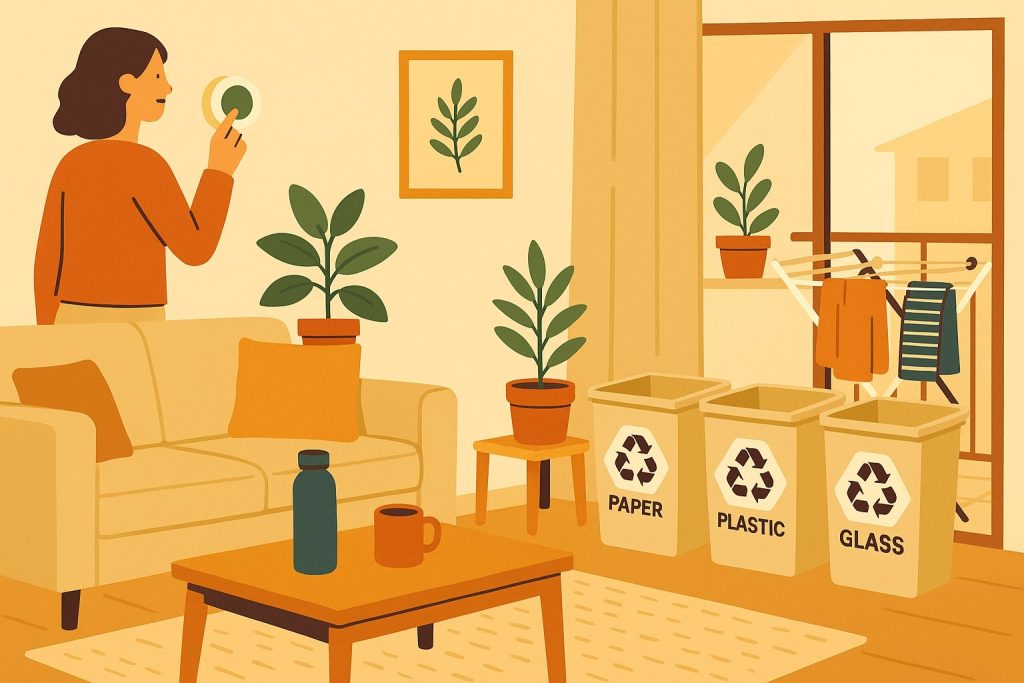
Final thoughts
Well, here we are—at the end of this sustainability deep dive. If your brain feels a bit fuller and your perspective a bit sharper, mission accomplished.
What we’ve learned is simple yet profound: Sustainability isn’t some abstract, far-off idea—it’s here, it’s now, and it’s personal.
Sustainability isn’t just about saving the planet—it’s about saving the future we actually want to live in.
We’ve unpacked the big stuff—energy, economics, equity—and zoomed into the everyday choices that shape it all. Whether it’s how we light our homes, drive to work, or vote in elections, each decision is a ripple. And when enough ripples align? You get a wave.
But the journey doesn’t end here. Now’s the time to keep asking questions, pushing boundaries, and staying curious.
Let’s chew on a few:
- How can local communities more effectively contribute to national sustainability efforts?
- What roles do innovation and technology play in achieving sustainability goals?
- How might changing consumer behaviors influence corporate sustainability practices?
- What are the challenges of enforcing sustainability regulations globally?
I’d love to hear your thoughts—drop them in the comments. Got an idea, a challenge, or even a question that kept you up last night? Bring it.
Let’s turn this blog into a conversation. Because sustainability isn’t a solo mission. It’s a collective adventure—and everyone’s invited.
Stay curious, stay kind, and keep moving forward. One choice at a time.
Until next time—cheers to living lighter, thinking deeper, and building a future worth passing on. 🌱
